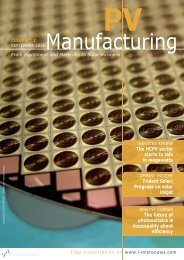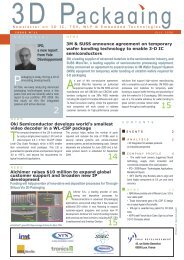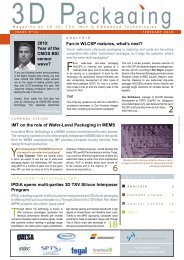the disruptive semiconductor technologies magazine - I-Micronews
the disruptive semiconductor technologies magazine - I-Micronews
the disruptive semiconductor technologies magazine - I-Micronews
You also want an ePaper? Increase the reach of your titles
YUMPU automatically turns print PDFs into web optimized ePapers that Google loves.
OCTOBER 2010 issue n°100<br />
THE DISRUPTIVE SEMICONDUCTOR TECHNOLOGIES MAGAZINE<br />
COMPOUND SEMICONDUCTORS<br />
Sony releases 400mW-output blue-violet laser diode for blu-ray disc<br />
Sony Corp released <strong>the</strong> "SLD3237VF," a new blue-violet laser diode expected to be used for recording and playing<br />
Blu-ray discs.<br />
It features a pulsed output as high as 400mW and<br />
supports "BDXL," a new standard for largecapacity<br />
Blu-ray discs.<br />
According to Sony, <strong>the</strong> SLD3237VF is <strong>the</strong> industry's<br />
first blue-violet laser diode that has an output of<br />
400mW or higher. The high output allows to use a<br />
wider variety of optical components such as lenses<br />
and prisms and, thus, to design hardware more<br />
freely.<br />
To realize <strong>the</strong> high output, innovative <strong>technologies</strong><br />
are necessary to prevent <strong>the</strong> end face of a laser<br />
resonator from being melted by <strong>the</strong> heat from laser (a<br />
phenomenon called "catastrophic optical damage"<br />
(COD)) and to enhance <strong>the</strong> crystal quality of GaN<br />
crystal, which is a constituent material for ensuring a<br />
high reliability, <strong>the</strong> company said.<br />
This time, Sony newly developed an end-face coating<br />
material and a film forming method and succeeded in<br />
heightening <strong>the</strong> optical output level that causes COD,<br />
compared with that of <strong>the</strong> company's 300mW-class<br />
laser diode.<br />
Moreover, to improve <strong>the</strong> crystal quality, Sony<br />
developed new MOCVD crystal growth equipment<br />
that is optimized for producing GaN materials. The<br />
equipment can grow crystals on multiple substrates<br />
at <strong>the</strong> same time and deal with a future increase in <strong>the</strong><br />
demand for laser diodes used for Blu-ray discs, <strong>the</strong><br />
company said.<br />
Fur<strong>the</strong>rmore, Sony developed a process and<br />
processing equipment that realize a high production<br />
efficiency in <strong>the</strong> process of processing wafers, which<br />
follows <strong>the</strong> crystal growth process.<br />
The SLD3237VF is mounted in a standard package<br />
with a diameter of 5.6mm. Its operating temperature<br />
range is from 0 to 85°C.<br />
The "SLD3237VF" with an output of 400mW (left) and <strong>the</strong><br />
"SLD3237VFR" with an output of 350mW.<br />
This time, Sony also released <strong>the</strong> "SLD3237VFR,"<br />
which has a pulsed output of 350mW and is mounted<br />
in a package with a diameter of 3.8mm. Its operating<br />
temperature range is from 0 to 90°C.<br />
www.sony.net<br />
Dow Corning to produce 100mm Silicon Carbide epitaxy<br />
Dow Corning announced that it will begin production of 100mm SiC epitaxy, providing a single source for SiC substrates<br />
used in power electronics device manufacturing.<br />
The new product expands Dow Corning’s<br />
product line beyond its existing offerings of<br />
76mm SiC wafers and epitaxy and 100 mm SiC<br />
wafers.<br />
Dow Corning supplies SiC and silicone materials that<br />
can be used in high power applications such as hightech<br />
communications, solar and wind energy systems,<br />
large scale electrical distribution grids, vehicles, and<br />
academic research.<br />
"We are committed to supporting <strong>the</strong> success of our<br />
customers by developing products that enhance<br />
performance while being cost effective," said Fred<br />
Bue<strong>the</strong>r, Commercial Manager, Dow Corning<br />
Compound Semiconductor Solutions. "Dow Corning<br />
is committed to continuing its leadership in supplying<br />
materials solutions to a broad cross section of <strong>the</strong><br />
global electronics industry. Our global expertise and<br />
collaborative approach enable us to deliver solutions<br />
that reliably perform, time after time."<br />
www.dowcorning.com<br />
UCSB researchers claim semi-polar nitride light extraction comparable to<br />
conventional LEDs<br />
Researchers at <strong>the</strong> University of California Santa Barbara report substantial improvement in <strong>the</strong> extraction efficiency of<br />
LEDs grown on semi-polar nitride substrates.<br />
The researchers claim that <strong>the</strong> efficiency's are<br />
comparable to those of conventional c-plane<br />
devices. The findings were published in Applied<br />
Physics Express.<br />
At a drive current of 20mA, <strong>the</strong> devices emitted<br />
SETI drives single chip germicidal UV LED optical output power to a record 100mW<br />
Sensor Electronic Technology Inc (SETI) says that, in its continuing program to develop UV LEDs for germicidal applications,<br />
it has achieved single chip constant current performance of 100mW in <strong>the</strong> germicidal wavelength range.<br />
According to <strong>the</strong> firm, this achievement exceeds<br />
<strong>the</strong> record for maximum optical power out of<br />
a single chip device of this type.<br />
SETI says that although this level of single chip<br />
performance is not yet available in its production<br />
LEDs, high power UV LED lamps are available<br />
under <strong>the</strong> UVCLEAN trademark with germicidal<br />
powers up to 50mW. “High power UV LEDs are<br />
essential to achieve <strong>the</strong> level of disinfection required<br />
in point-of-use and point-of-entry water treatment<br />
systems,” said Remis Gaska, president and CEO<br />
of SETI. “This ongoing development of large area<br />
high power UV LEDs will help to reduce <strong>the</strong> price<br />
per milliwatt and allow UV LEDs to enter cost<br />
sensitive disinfection markets.”<br />
31.1mW, with external quantum efficiency (EQE) of<br />
54.7%.<br />
Researchers expect non-polar and semi-polar nitride<br />
materials to produce improved efficiency LEDs<br />
because of reduced spontaneous and straindependent<br />
(piezoelectric) polarization fields. These<br />
polarization fields tend to pull electrons and holes<br />
apart in <strong>the</strong> light-emitting active region, thus reducing<br />
<strong>the</strong> chances of recombination occurring as photons.<br />
www.ucsb.edu<br />
The firm announced that it had been awarded a<br />
$475,000 Small Business Innovation Research<br />
(SBIR) Phase II award from <strong>the</strong> US National Science<br />
Foundation (NSF) to develop point-of-use (POU)<br />
drinking water disinfection systems based on deep<br />
ultraviolet LEDs (DUV LEDs).<br />
www.s-et.com<br />
Copyrights © Yole Développement SA. All rights reserved - Recycled paper<br />
13
















